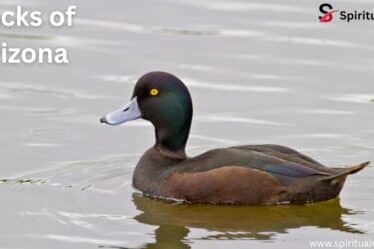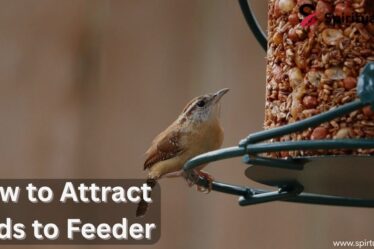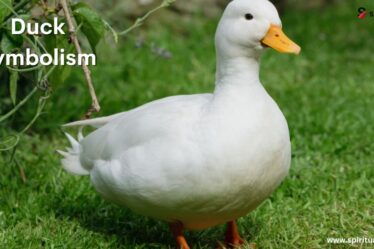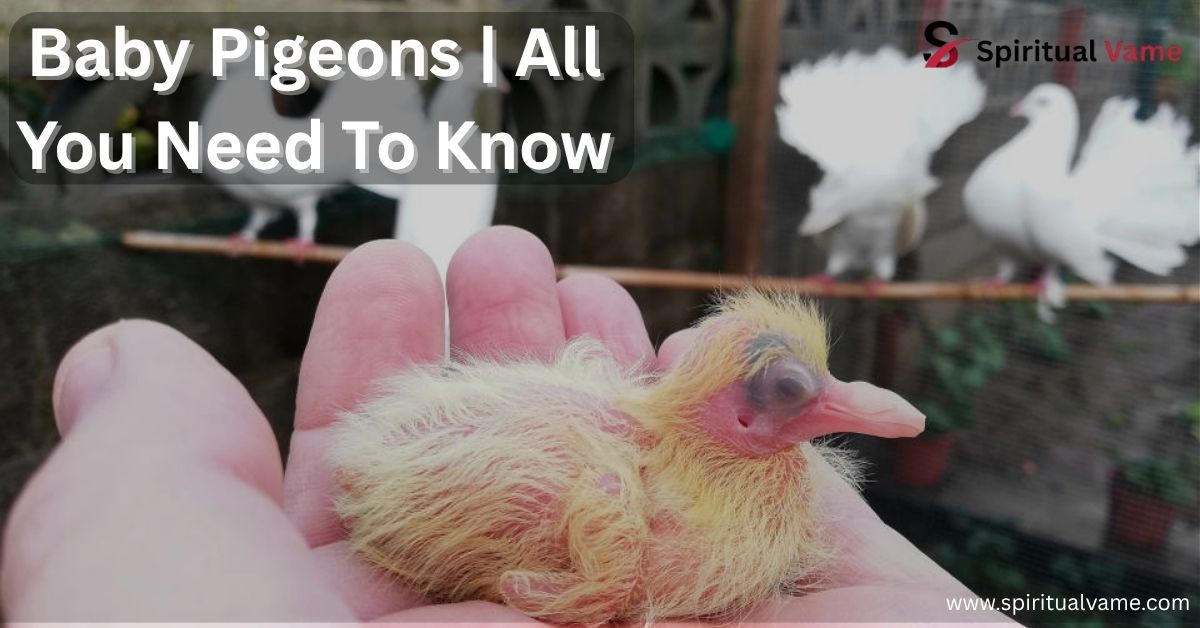
Have you ever wondered where baby pigeons are? We see adult pigeons everywhere—on streets, rooftops, and bridges. But baby pigeons are rarely seen. This makes many people curious about how and where they grow. In this article, we’ll explore baby pigeons: all you need to know about their looks, life, and care.
We’ll explain why you don’t see them, how they’re raised, and what makes them so unique. From egg to flight, baby pigeons go through amazing changes. Whether you live in a city or the suburbs, you’ll learn fun and surprising facts. This is your full guide to baby pigeons: all you need to know
What Does a Baby Pigeon Look Like?
A baby pigeon, or squab, doesn’t look like the typical city pigeon you’re used to seeing. When it first hatches, it’s small and awkward with pinkish skin, sparse down feathers, and closed eyes. The beak, especially the cere—the soft, fleshy part near the nostrils—is large and prominent compared to its tiny head. As the chick grows, its plumage begins to thicken, and it slowly starts resembling a juvenile pigeon.
During their first few weeks, baby pigeons develop quickly. Their feathers grow, their eyes open, and they become stronger. But since they stay hidden in high or sheltered nests, usually on ledges, eaves, or balconies, most people never get a glimpse of them at this stage. This is why spotting a hatchling or fledgling in the wild is so rare.
Join the Spiritualvame Community
Love learning about birds like the mourning dove, wood pigeon, and even predators like the peregrine falcon? The Spiritualvame community is the perfect place to explore your curiosity. By joining, you’ll get access to expert guides, fun facts, and real experiences from bird lovers around the world.
From the nesting behavior of crow and magpie to how pigeons raise their clutch of chicks, there’s always something new to discover. You’ll also get updates on bird conservation, rare sightings, and useful tips for spotting hidden squabs in your neighborhood.
Check out our Baby Pigeon below
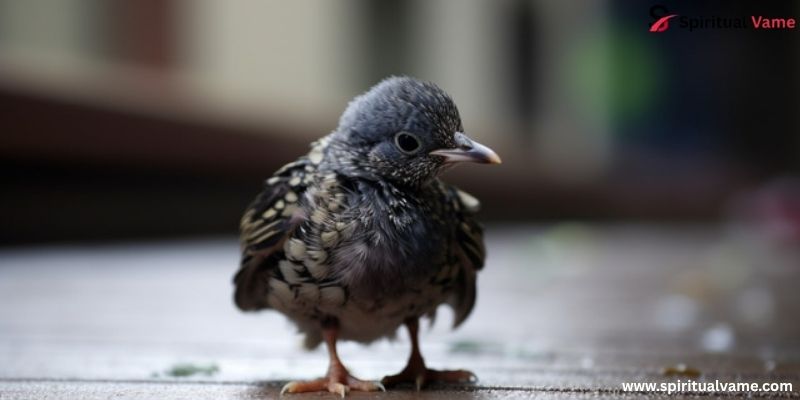
Want to actually see a squab grow? Our video below shows the full journey—from egg stage to fledging. Watch how feral pigeons in cities like New York and Chicago raise their young in secret spots most of us walk by every day. You’ll get a rare look at their plumage changes, feeding habits, and early attempts at flying.
The footage also reveals how parent pigeons care for their brood, using their crop to produce rich pigeon milk. It’s a must-see if you’ve ever been curious about the hidden life of baby pigeons.
The Lifecycle of a Pigeon
The life of a pigeon begins inside a fragile white egg tucked safely into a hidden nest. After about 18 days of incubation, the egg hatches into a tiny altricial chick—completely helpless and dependent on its parents. During the early stages, both mother and father share the tasks of brooding, feeding, and keeping the chick warm.
As the squab grows, it passes through the weaning and fledging stages, developing flight feathers and learning to move around. In just a few weeks, the chick goes from blind and featherless to strong and ready to leave the nest. From there, it becomes a juvenile and eventually a fully grown adult, capable of starting the cycle all over again.
Pigeon Breeding Behaviors
Pigeons are monogamous birds, meaning they often stay with one partner for life. They’re known for their close bonds and shared parenting duties. Breeding happens throughout the year, especially in warmer climates. Once a pair mates, the female usually lays two eggs per clutch, often within a week of mating.
The chosen nest site is usually in a high, hidden spot—under bridges, on rooftops, or inside old buildings. The pair will reuse their nest multiple times, adding new materials each season. Both parents take turns incubating the eggs and later feeding their squabs with crop milk.
Egg Stage
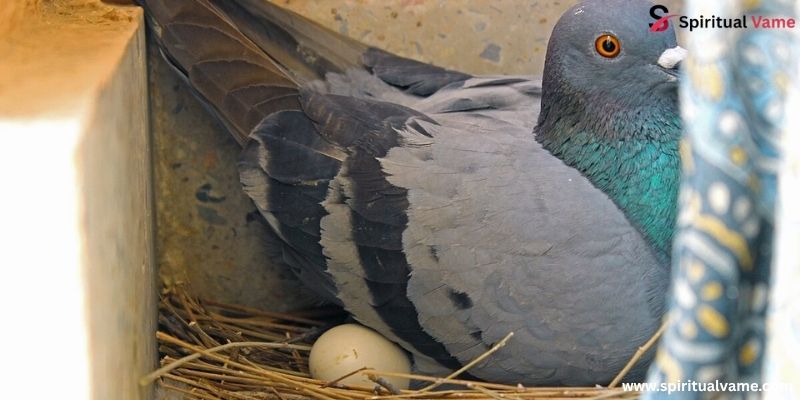
Pigeon eggs are small, smooth, and pure white. They’re laid in pairs and incubated for about 17 to 19 days. Both the male and female take turns sitting on the eggs, keeping them warm and safe from predators like the raccoon or crow.
During this time, the parents are highly protective. Even in busy urban areas, they’ll defend their eggs from curious humans or animals, often returning to the nest the moment danger has passed.
Growth Stages
Once the eggs hatch, the hatchlings begin their rapid development. In the first week, they can barely move. By week two, they begin to grow feathers, and by week three, their eyes open fully, and they begin exploring their nest.
During this period, the chicks are fed crop milk, packed with prolactin and nutrients. By four weeks, they’re nearly the size of adult pigeons and ready to test their wings.
Fledging Process
The fledging stage is when a squab begins to prepare for flight. Around 4 to 6 weeks old, the young pigeon flaps its wings more often and may hop around the rooftop or ledge where it was born.
By the end of the fledging period, most baby pigeons are strong enough to leave the nest. But they may still rely on their parents for food and protection for a few more days before becoming completely independent.
Why Don’t You See Baby Pigeons?
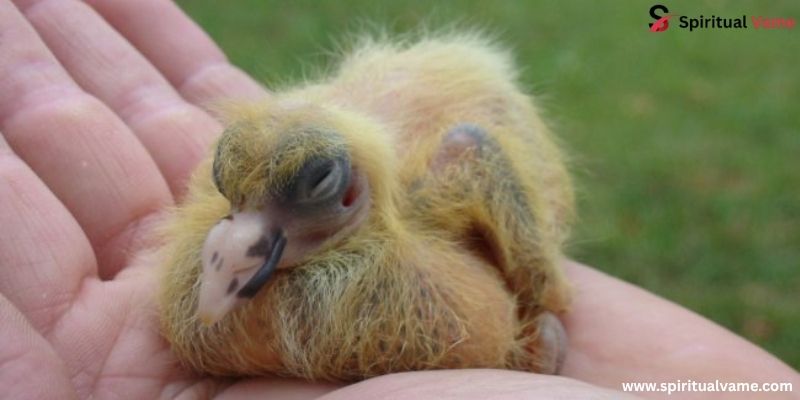
The main reason is simple—baby pigeons grow up in hidden places. Unlike birds that nest in trees, pigeons choose tucked-away spots like building eaves, balconies, and bridges. This keeps their brood safe from predators and harsh weather.
Another reason is how quickly squabs develop. By the time they leave the nest, they look nearly identical to adults. So even if you’ve seen one, you probably didn’t realize it was a juvenile!
Feeding and Nutrition for Baby Pigeons
Feeding baby pigeons is a unique process compared to other birds. For the first week or two, they survive entirely on a substance called pigeon milk. It’s not like cow’s milk—this thick, nutritious fluid is made in the parent’s crop and delivered mouth-to-mouth.
As the squab grows, its diet changes. The parents start mixing in seeds, grains, and small fruits, helping the chick get used to adult food. By the time the bird is ready to fledge, it’s eating solid food and learning how to peck and forage on its own.
Introduction to Pigeon Milk
Pigeon milk is a thick, creamy substance rich in fats and proteins. Both male and female pigeons produce it inside their crop. Stimulated by the hormone prolactin, this milk helps feed their young during the first vital days of life.
It’s one of the most fascinating aspects of pigeon biology and is crucial for the survival of altricial chicks who can’t digest solid food yet.
Feeding Process
During feeding, the parent inserts its beak into the chick’s mouth and regurgitates crop milk directly into the chick’s throat. It’s a quick but frequent process, happening several times a day.
This continues for about 7–10 days before seeds and grains are gradually introduced.
Dietary Changes
As the chick develops, it needs more energy and different nutrients. The parents begin offering semi-digested grains along with pigeon milk to help the chick transition.
By the time it fledges, it’s eating adult food and no longer needs milk. This diet shift is a key part of healthy growth and survival.
Protection and Survival
Survival in the city can be dangerous, but pigeons have adapted well. Their nesting habits keep squabs hidden from predators like cats, hawks, and even other birds like crows and magpies.
Parents stay close, often distracting predators or shielding their chicks with their bodies. These care strategies help improve the odds for their young, especially in suburban and urban areas filled with threats.
Nesting Habits
Pigeons build simple nests using sticks, twigs, and even trash. They often reuse old nests for multiple broods, adding new layers each time. These nests are found on rooftops, in building crevices, and under bridges.
The goal is always the same: protect their young from predators and keep them warm until they can survive on their own.
Predator Avoidance and Parental Care Strategies
To avoid predators, parents remain alert and secretive. They limit movement near the nest and only return when safe. If a predator approaches, they’ll sometimes feign injury to draw attention away.
Both parents play vital roles in keeping their brood safe and healthy, showing an incredible bond and dedication to their chicks.
Survival Rates
Not every baby pigeon survives to adulthood. In the wild, dangers like hawks, raccoons, and environmental threats reduce survival rates. But in cities, where natural predators are fewer and food is abundant, more squabs make it.
That said, many still fall victim to falls, disease, or starvation, especially if separated from their parents too early.
Caring for Orphaned or Injured Baby Pigeons
If you find a baby pigeon alone, it’s important to act with care. Never try to feed it cow’s milk. Instead, keep it warm and call a local wildlife rehab center. They can offer proper nutrition and care for injured or orphaned birds.
Rehabilitation gives many young squabs a second chance at life, especially if they were born in unsafe locations or abandoned too soon.
The Role of Pigeons in the Ecosystem
While often overlooked, pigeons play a big role in urban ecosystems. They help with seed dispersal, act as scavengers to clean up waste, and serve as prey for predators like Cooper’s hawks and peregrine falcons.
Even baby pigeons, once grown, continue the cycle—adding balance to the complex relationship between humans and wildlife in urban habitats.
Myths and Facts About Baby Pigeons
One common myth is that baby pigeons don’t exist. The truth is, we rarely see them because of their hidden nests and fast growth. Another myth is that pigeons carry more disease than other birds. In reality, they’re no more dangerous than sparrows or doves.
Summary
Baby pigeons may be hard to spot, but they live fascinating lives filled with love, growth, and survival. From hidden urban nests to the wonders of crop milk, their journey is packed with surprises. Now that you know the signs, you might just catch a glimpse of a young squab growing up in the city.
Would you like help finding free-use images, diagrams, or videos to go with this article?

